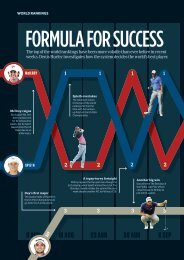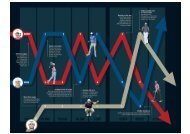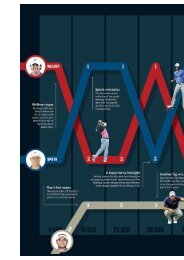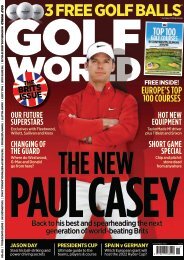You also want an ePaper? Increase the reach of your titles
YUMPU automatically turns print PDFs into web optimized ePapers that Google loves.
TODAY’S GOLFER JANUARY 2016 (NOVEMBER 26-DECEMBER 28) <strong>342</strong><br />
JAN 2016 ISSUE <strong>342</strong> NOV 26-DEC 28 £4.50<br />
Winter golf<br />
essentials<br />
Caddie<br />
secrets<br />
From Bedford to<br />
Bangkok, with Ian<br />
Poulter’s bag man<br />
WWW.TODAYSGOLFER.CO.UK<br />
n Chips over bunkers n Drives with OB<br />
right n That shot after a shank... & more<br />
Clues from<br />
your clubs<br />
Your kit reveals where<br />
you could improve<br />
10 rules<br />
of driving<br />
By Greg Norman
DRIVING<br />
More launch, more yards<br />
Focus on your upper body to create more height and longer drives<br />
Fault: Loss of distance via low launch.<br />
Fix: Keep the chest behind the ball<br />
through impact to send the ball higher.<br />
One of the key things launch monitors<br />
have shown us is where distance comes<br />
from. By revealing how impact conditions<br />
like angle of attack affect ball flight, they<br />
have given us a better understanding of<br />
the technique we need to hit the ball<br />
further. For the vast majority of golfers,<br />
longer drives mean launching the ball<br />
higher. The good news for us is that while<br />
phrases like launch angle and dynamic<br />
loft sound complicated, achieving a<br />
higher launch is actually very simple.<br />
Here, I’ll show how a simple focus on<br />
your upper body can help you launch it<br />
higher, and hit it further.<br />
Kick a football<br />
When a striker balloons it<br />
over the bar, pundits groan<br />
“he leaned back as he struck<br />
the ball”. When your chest<br />
or sternum is behind the<br />
object you’re striking, you will<br />
inevitably hit it up. While that<br />
position may not be great for<br />
strikers, it’s perfect for golfers<br />
trying to hit the driver higher.<br />
Lean back and let rip<br />
Set up to promote this leant-back<br />
impact, with the ball opposite your lead<br />
heel and your trail shoulder lower. During<br />
the swing, fix that thought of a footballer<br />
leaning back in your head. As you swing<br />
down, aim to increase the feeling by<br />
leaning back through impact to send the<br />
ball up and out on a high launch.<br />
<strong>TG</strong> TOP 50<br />
KEVIN FLYNN<br />
TOURNERBURY GC, HANTS<br />
Fellow of the<br />
PGA and a<br />
European<br />
Golf<br />
Development<br />
Consultant.<br />
30 ISSUE <strong>342</strong> TODAYSGOLFER.CO.UK
Fault<br />
Fixer<br />
Shoot at the clouds<br />
If I gave you two golf balls<br />
and asked you to hit one at<br />
the clouds and the other<br />
along the ground, you<br />
would instinctively develop<br />
two different techniques<br />
to create those outcomes,<br />
the first sweeping upward<br />
on the ball and the second<br />
squeezing down.<br />
High finish<br />
One positive side effect of shooting<br />
for the clouds is that you will find it<br />
easier to make the full, free-flowing<br />
followthrough that is the hallmark of<br />
a powerful, high launch.<br />
Let it fly<br />
To develop your own<br />
high launch, think<br />
simply of sending the<br />
ball to the sky. Do this<br />
and that leant-away<br />
impact position, your<br />
sternum behind the ball,<br />
will take care of itself.<br />
MORE TIPS ONLINE<br />
www.todaysgolfer.co.uk/tips<br />
TODAYSGOLFER.CO.UK ISSUE <strong>342</strong> 31
‘With the<br />
technology<br />
they have now,<br />
I’d have been<br />
hitting it 340<br />
yards, easily’<br />
80 ISSUE <strong>342</strong> TODAYSGOLFER.CO.UK
10 RULES<br />
Greg Norman on...<br />
Great drives<br />
The Great White Shark was one of the greatest players of all-time with the<br />
big dog. He tells you how to gain power and accuracy – at the same time<br />
WORDS ROB Mc GARR PICTURES MARK NEWCOMBE, GETTY IMAGES<br />
reg Norman is one of the best<br />
G drivers in golf history. Don’t just take<br />
our word for it, take Nick Price’s:<br />
“The best driver I ever saw was Greg<br />
Norman,” says the Zimbabwean.<br />
Norman spent more than 300 weeks as<br />
the number one golfer in the world, topping<br />
the World Golf Rankings for seven years and<br />
winning 86 tournaments. During that time, his<br />
greatest weapon was his length and accuracy<br />
off the tee, which was enough to intimidate<br />
opponents, especially when he could carry his<br />
ball beyond where theirs had finished.<br />
If you want to bomb it long and straight,<br />
just follow The Shark’s 10 bits of advice…<br />
1The first thing you’ve got to do is visualise<br />
your shot. Whether you want to take on<br />
the aggressive play or not, it’s up to you and<br />
how you’re feeling at that moment. You’ve got<br />
to decide what you want to do so you can<br />
fully commit to it.<br />
2You’ve got to know where not to hit it.<br />
Don’t just try to hit it down the middle of<br />
the fairway. To me, it’s about using all of the<br />
fairway, not just half of it. If there’s trouble<br />
down the left and your natural shot shape is<br />
left to right – as mine was – aim down the left<br />
and take that side out of play. It’s not being<br />
negative; it’s using the layout of the course to<br />
your advantage.<br />
3I like to ‘spot target’. When you’ve<br />
visualised your shot, you know where you<br />
want the ball to end up. You can then pick a<br />
target in the distance you want the ball to<br />
head towards that will let it finish where you<br />
want it to finish.<br />
4I always vary the tee height depending<br />
on the type of shot I am trying to hit.<br />
Teeing it higher or lower is one of the easiest<br />
ways to change the shot you hit, because it<br />
changes your impact with the ball and the<br />
spin you put on it.<br />
5The last word I say to myself before<br />
I start my swing is ‘rhythm’. The first 18-<br />
24 inches of the backswing is the most<br />
important part of the swing. That’s where you<br />
set the club. If you take it away for the first 18<br />
inches with rhythm, the position takes care of<br />
itself. You just keep rotating the body and the<br />
club will find the right position.<br />
6Try to maintain your triangle as long as<br />
possible. At address, there’s a triangle<br />
formed between your arms and your chest.<br />
The longer I keep that triangle intact, the<br />
more extension I get. You should have the<br />
same swing with your driver as the rest of<br />
your clubs. People talk about a ‘driver swing’<br />
and an ‘iron swing’, but I don’t know why<br />
you’d want to have two swings to work on –<br />
it’s hard enough getting one right! You want to<br />
replicate your standard swing as much as you<br />
can, whether you’re hitting a 300-yard drive<br />
or a 100-yard wedge.<br />
7My power all came from my hips. I have<br />
a move called ‘right pocket back, right<br />
pocket forward’. You pull the right pocket<br />
back in the takeaway and push it forward in<br />
your downswing. The harder I wanted to hit<br />
the ball, the more I pulled my right pocket<br />
back. Then I pushed my right pocket forward,<br />
through the back of the ball. I could crank it<br />
up by 15-20 per cent, just by getting that extra<br />
clubhead speed with body rotation. You’re not<br />
trying to speed up your arms; they speed up<br />
automatically with your body.<br />
8It works for anybody. I look at amateur<br />
golfers, and too many times their right<br />
pocket stops at impact – or even before<br />
impact. Keep that right pocket moving<br />
forward towards the ball and you’ll pick up<br />
more distance and accuracy – I guarantee it.<br />
9With the technology they have now, I’d<br />
have been hitting it 340 yards, easily.<br />
I tested my old equipment against the<br />
modern gear and the difference was 48 yards.<br />
That said, don’t change your<br />
10 equipment for the sake of it. I’m using<br />
a lot of the same specifications today as<br />
I have for the last 30 or 40 years. The grips<br />
are the same and my shafts are the same<br />
length. If you find something that works, stick<br />
with it. Tiger Woods is struggling with his driver,<br />
but he can hit his 3-wood 300 yards and<br />
straight. If I were him, I’d try to replicate the<br />
specification from my 3-wood in my driver.<br />
TODAYSGOLFER.CO.UK ISSUE <strong>342</strong> 81
BEERS,<br />
BIRDIES<br />
& BANTER<br />
<strong>TG</strong> spent a day quizzing best mates Darren Clarke and<br />
Lee Westwood. Some of the answers were safe to print...<br />
WORDS ROB Mc GARR PICTURES HOWARD BOYLAN, GETTY IMAGES<br />
ee Westwood and Darren Clarke (or<br />
L ‘Wetwood’ and ‘Clarkey’ as they refer<br />
to each other) have been close friends<br />
for longer than Jordan Spieth has been alive.<br />
They’re always on hand when there’s an<br />
opportunity to mock the other, the barbecue is<br />
being lit or a nice cold beer is cracked open.<br />
But it’s not all jokes and jibes. They are the<br />
second most successful partnership in Ryder<br />
Cup history, taking down the likes of Tiger<br />
Woods, Phil Mickelson, David Duval, Jim Furyk,<br />
Mark O’Meara and Tom Lehman, among others.<br />
Clarke has a Major under his belt – the 2011<br />
Open at Royal St George’s – while Westwood is<br />
a former world number one.<br />
Get the two of them together and set the tape<br />
recorder running and the result is an<br />
entertaining insight into their relationship with<br />
each other and the game they both love. And<br />
some of it was even safe to print…<br />
Who hits it the furthest out of the two of you?<br />
DC: Him. I’m older than him, though.<br />
LW: It’s debatable, really.<br />
DC: We used to be very similar.<br />
LW: We’re probably such good Ryder Cup<br />
partners – especially foursomes – because we<br />
hit it almost exactly the same distance.<br />
And who’s got the better short game?<br />
LW: Him, no question. He’s got a short game.<br />
That puts him streets ahead.<br />
DC: I’ll take the Fifth Amendment on this one!<br />
LW: I’m better at putting from long range.<br />
Especially around bunkers…<br />
DC: He’s better at putting in all respects. If<br />
there’s a big important putt, we’d want him on it.<br />
Who’s stronger in the gym?<br />
LW: There’s not a lot in it, really.<br />
DC: We’d be pretty close. We’ve both had our<br />
spells of getting bigger, getting stronger and<br />
all that.<br />
What’s the strongest part of your game?<br />
DC: Mental.<br />
LW: [Interrupting] He is. He is mental.<br />
DC: [Laughs] The strongest part of my game<br />
➔<br />
62 ISSUE <strong>342</strong> TODAYSGOLFER.CO.UK
CLARKE v WESTWOOD<br />
In charge<br />
Might one<br />
captain the<br />
other in Ryder<br />
Cup 2016?
Bag for life<br />
Mundy has<br />
25 years’<br />
caddying<br />
experience.<br />
68 ISSUE <strong>342</strong> TODAYSGOLFER.CO.UK
TERRY MUNDY<br />
The man<br />
behind<br />
the bag<br />
Terry Mundy has been Ian Poulter’s right-hand man for nearly a<br />
decade. He lifts the lid on what life is really like inside the ropes<br />
WORDS ROB Mc GARR PICTURES ANGUS MURRAY, GETTY IMAGES<br />
n the past, anyone with two<br />
I<br />
shoulders and the ability to grunt,<br />
“Aye, a seven’ll get there” could be a<br />
caddie. But things have changed. The role of<br />
caddie is now a highly technical, respected,<br />
and, in some cases, well remunerated one. In a<br />
world where one shot can cost you hundreds<br />
of thousands, the top professionals<br />
acknowledge that golf is a two-man game, and<br />
having the right man on the bag can be the<br />
difference between a missed cut and a<br />
tournament win.<br />
“The top-100 players have fairly high<br />
demands about what they want from their<br />
caddie,” says Poulter. “Terry is part of the new<br />
breed of caddie. He adopts the same attitude<br />
to professionalism that I do. We think the same<br />
way about the game. He follows the same<br />
thought processes as me and has the same<br />
work ethic. The more he knows<br />
about a course, the more he<br />
can step in and be confident<br />
enough to say if he thinks<br />
I might be about to<br />
do the wrong<br />
thing. He is<br />
absolutely not a<br />
‘yes man’. He has a<br />
strong character and<br />
is not afraid to voice an opinion. We have<br />
become good mates. I almost spend more<br />
time with him than I do my wife!”<br />
Having chopped and changed caddies<br />
during his first few years on Tour, Poulter has<br />
found his man in Mundy and stuck with him.<br />
This season will be their 10th together, so it<br />
seems the perfect time to sit down with the<br />
48-year-old and find out what life is like on the<br />
other side of the bag. Unlike occasionally tightlipped<br />
Tour Pros, Mundy was happy to talk<br />
about the preparation that goes into a<br />
tournament, how you can save shots with<br />
better strategy, and what happens when he<br />
makes a mistake…<br />
How did you get into caddying?<br />
I’ve been caddying since 1989. I used to work<br />
as a printer and I lived in<br />
Bletchley, down the road from<br />
Woburn. I used to drink in a pub<br />
in Brickhill and over the years<br />
I got to know a few players<br />
and caddies. Alicia Dibos<br />
turned up for The Ford<br />
Ladies Classic one year<br />
without a caddie, so<br />
I said I’d do it. I was a<br />
half-decent golfer, so<br />
I understood the game. I did that for a couple of<br />
years, just doing the odd week here and there,<br />
and then redundancies came up at the printing<br />
firm. My plan was to take redundancy, have a<br />
bit of fun travelling around Europe caddying for<br />
six months, and then get back into printing.<br />
What changed?<br />
I got a little bit of success quite early. In my<br />
third or fourth tournament, we finished second<br />
and I picked up a nice cheque. I thought, ‘Hang<br />
on, if I get a good player and do that regularly,<br />
I could earn more at this than I do printing’.<br />
I got a couple of decent results early on, and<br />
then got offered a job with Alison Nicholas,<br />
who was one of the top players on the Ladies’<br />
Tour at the time. The results were even better<br />
with her, and so were the cheques. I worked for<br />
Trish Johnson, Laura Davies and a few other<br />
female golfers, did a bit of work on the<br />
European Tour with Jonathan Lomas and<br />
Ignacio Garrido, and then hooked up with Ian.<br />
How good a golfer were you? Do you still play<br />
the game?<br />
I played off three. I was never good enough to<br />
consider playing the game for a living, but<br />
I played in club scratch teams and stuff like<br />
that. I play to about six or seven now, but most<br />
➔<br />
TODAYSGOLFER.CO.UK ISSUE <strong>342</strong> 69
PATRICK REED<br />
It’s good to be<br />
BAD<br />
US superstar Patrick Reed doesn’t care<br />
whether you love him – or hate him<br />
WORDS GARRETT JOHNSTON PICTURES GETTY IMAGES<br />
want people to know who I am,” says Patrick<br />
I Reed. He shouldn’t have too many concerns on<br />
that front. The 25-year-old from San Antonio, Texas,<br />
only turned pro four years ago, but his short career has<br />
already made countless headlines, cementing his role as<br />
golf’s biggest bad boy.<br />
He’s been accused of cheating in college events and<br />
stealing from fellow students. He was expelled from his first<br />
college after two arrests for underage drinking, forced to<br />
apologise after directing a profanity-laced homophobic slur<br />
at himself following a three-putt during a PGA Tour event in<br />
Shanghai, and became the pantomime villain at Gleneagles<br />
after repeatedly antagonising the home fans.<br />
But, of course, those headlines don’t tell the full story, and<br />
Reed’s on-course performances are reason enough for<br />
people to know his name. After making his PGA Tour debut<br />
in 2011, Reed secured starts in 12 events during 2012,<br />
mainly through the incredibly competitive Monday prequalifying.<br />
Having earned those spots, he proved he<br />
warranted them, making seven cuts and taking home over<br />
$300,000. At the end of that season, he went through every<br />
round of Q School to secure a PGA Tour card for 2013, when<br />
he would win his first title – the Wyndham Championship in<br />
a play-off against a little-known fellow Texan going by the<br />
name of Jordan Spieth.<br />
2014 saw two more wins – the WGC-Cadillac<br />
Championship, where Reed beat Bubba Watson and Jamie<br />
Donaldson by one shot – and a dominant performance at<br />
the Humana Challenge, where Reed set a PGA Tour record<br />
for most strokes under par through 54 holes. Three rounds<br />
of 63 saw him 27-under-par on Saturday evening. Those<br />
victories made Reed only the fifth golfer to earn three PGA<br />
Tour wins before his 24th birthday, joining Tiger Woods, Phil<br />
Mickelson, Rory McIlroy and Sergio Garcia. You can since<br />
add Jordan Spieth’s name to that list, of course.<br />
But Reed is not content being a footnote amongst big<br />
names. He has a burning desire to be the main man, and<br />
anyone who stands in his way should be prepared for one<br />
hell of a fight.<br />
We caught up with him after the third-round of the BMW<br />
Championship. While most of us would be pretty content<br />
having signed for a 69, Reed went straight to the range for<br />
45 minutes honing his game. Satisfied with his work, he was<br />
in relaxed but focused mood as he chatted about everything<br />
from beating Spieth, past controversies, Ryder Cups, and<br />
mac and cheese… ➔<br />
TODAYSGOLFER.CO.UK ISSUE <strong>342</strong> 43
COBRA<br />
Return of the King<br />
Two new multi-adjustable drivers bear Cobra’s legendary moniker<br />
obra made headlines a month<br />
C<br />
ago when it resurrected the<br />
legendary King name in its new<br />
Ltd driver. That club, with its unique<br />
SpacePort technology, was Cobra’s top-ofthe-range<br />
driver for 2016, with a price tag<br />
to match. Now the King moniker has been<br />
applied to two more models featuring<br />
tons of adjustability – but with sub-£300<br />
rrps. Both let you change your launch<br />
conditions, in very different ways.<br />
Cobra King F6+ £299<br />
Cobra says the F6+ is its longest, most<br />
adjustable driver to date. In a first for golf,<br />
the F6+ has a carbon sole track. This,<br />
along with a carbon crown, allowed<br />
Cobra’s engineers to save 18g of mass to<br />
use in a sliding weight which will change<br />
the launch conditions.<br />
It can be moved to five positions, from<br />
just behind the face (for lower spin and<br />
launch) to the back of the head (to<br />
increase MOI and forgiveness).<br />
We were among the first people in<br />
Europe to test the F6+, and our first<br />
impression was that it’s a solid club with<br />
simple tech that works (watch the video<br />
at www.todaysgolfer.co.uk/cobraf6)<br />
<strong>TG</strong> test pro Chris Ryan hit the F6+ on a<br />
launch monitor and saw a 2.8° increase in<br />
launch angle with the weight at the back.<br />
This extra launch increased his carry<br />
distance by 10 yards, which demonstrates<br />
Cobra F6+<br />
An 18g sole<br />
weight is located in<br />
a carbon track and<br />
lets you move the<br />
centre of gravity<br />
from front to back.<br />
84 ISSUE <strong>342</strong> TODAYSGOLFER.CO.UK
the importance of setting up such a<br />
high-tech driver properly to suit your<br />
swing characteristics.<br />
That’s not all the technology either.<br />
There’s also a super-hot variable<br />
thickness 8-1-1 titanium face, a speed<br />
channel around the perimeter of the<br />
face and a MYFLY8 adjustable hosel,<br />
which lets you tune the loft, lie and shot<br />
bias to your own game.<br />
Cobra King F6 £249<br />
The F6 doesn’t have the sliding weight<br />
on the sole, but it does feature the<br />
ability to move the centre of gravity<br />
using a moveable weight.<br />
This 10g plug can be switched<br />
between front and back locations to<br />
offer either a penetrating ball flight with<br />
more run or a towering shot shape for<br />
Cobra F6<br />
There’s no sliding<br />
track, so the 10g<br />
weight can be<br />
switched from<br />
front to back to<br />
alter launch.<br />
maximum carry distance. When we got<br />
it on a launch monitor, pro tester Chris<br />
Ryan hit the F6 with the weight in both<br />
its forward and back positions. An<br />
increase of 1.8° in launch angle with the<br />
weight in the rear port added an extra<br />
five yards of carry.<br />
Like the F6+, Cobra’s weight-saving<br />
tech comes into play with a lightweight<br />
titanium crown, a variable thickness<br />
8-1-1 titanium face and speed channel<br />
allowing extra weight to be positioned to<br />
increase MOI and ball speeds.<br />
● Details: Cobra F6+ £299. Stock<br />
shaft: Matrix Black Tie 65M4. Cobra<br />
King F6 £249. Stock shaft: Matrix Red<br />
Tie 60Q4. Both models are available<br />
with black, blue or white crowns.<br />
www.cobragolf.co.uk<br />
New<br />
Gear<br />
Cobra King F6<br />
fairway, £179<br />
Cobra has designed the F6 fairways to<br />
match both drivers. A 20g sole weight can<br />
be switched between either a front or back<br />
location allowing you to tune spin, launch<br />
and shot trajectory to your own game.<br />
There’s also a speed channel around the<br />
clubface and an adjustable hosel means<br />
you can tailor lofts, lies and shot bias.<br />
● Details: 3-4F (adjustable 13°-16°); 5-6F<br />
(17°-20°); 7-8F (21°-24°).<br />
Both F6 drivers are available with black, blue or white crowns,<br />
while the thin, lightweight titanium face features the<br />
next generation of Cobra’s “E9” zoning, which uses variable<br />
thicknesses to create a larger sweetspot across the entire face.<br />
Cobra King F6<br />
hybrid, £149<br />
The sole weight in the hybrid is located to<br />
increase MOI and forgiveness. Both fairway<br />
and hybrid are cast 17-4 stainless steel<br />
heads and feature springy carpenter steel<br />
faces to maximise ball speeds. Hybrid only<br />
available in black.<br />
● Details: Lofts 2-3H (adjustable 16°-19°);<br />
2-4H (19°-22°); 4-5H (22°-25°). Stock<br />
shaft: Matrix Red Tie HQ4.<br />
TODAYSGOLFER.CO.UK ISSUE <strong>342</strong> 85
Courses<br />
& Travel<br />
WHERE TO PLAY AT<br />
HOME AND ABROAD<br />
EDITED BY KEVIN BROWN<br />
Burhill Old<br />
Proof a great<br />
round in Surrey<br />
doesn’t have to<br />
break the bank .
REGIONAL GUIDE<br />
Surrey’s hidden value<br />
If you thought quality golf in the county meant exorbitant green fees, think again<br />
WORDS KEVIN BROWN<br />
f you’re looking for quality inland<br />
I golf, Surrey is the place to go: the<br />
classiest of London suburbia is rife<br />
with stunning inland courses of the heathland,<br />
parkland and downland variety guaranteeing<br />
the best inland golf in the country.<br />
You’ve got the trinity of the famous Ws –<br />
Woking, Worplesdon and West Hill – not to<br />
mention the even more famous and historic<br />
Wentworth and Walton Heath with a handful<br />
of simply sensational courses between them.<br />
However, all this amazing world-class action<br />
comes at a rather hefty price – usually<br />
handsomely three-figures plus... though these<br />
days, since the new owners moved in at<br />
Wentworth, visitors can’t get a game even if<br />
they are prepared to cough up over £300!<br />
But don’t despair: Surrey isn’t solely about<br />
courses requiring you to take out a second<br />
mortgage in order to tee it up. Look past those<br />
high-profile clubs and you’ll discover an<br />
impressive array of hidden gems which<br />
provide unbelievable value… considerably<br />
less than three figures and, in many cases,<br />
hovering well below the £50 mark. You can<br />
even play some, such as Guildford – home to<br />
a wonderful downland layout and the oldest<br />
club (1886) in the county – for £30 if you’ve<br />
got a 2-FORE!-1 voucher and you can’t get<br />
much better or fairer than that. ➔

















